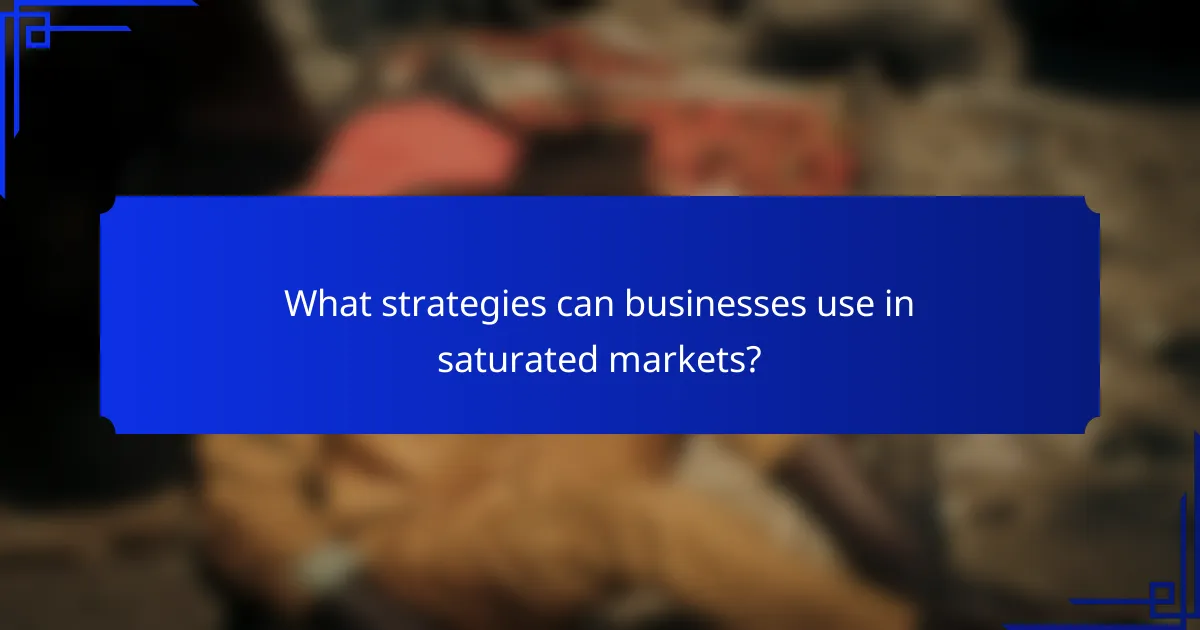Saturated markets present unique challenges for businesses, yet they also offer opportunities for those willing to innovate and adapt. By differentiating their offerings and enhancing value propositions, companies can carve out a niche and attract targeted audiences. Successful case studies illustrate how strategic partnerships and data-driven insights can lead to significant growth, even in highly competitive landscapes.

What strategies can businesses use in saturated markets?
Businesses in saturated markets can adopt several strategies to stand out and thrive. These include differentiating their offerings, enhancing their value propositions, segmenting their target audiences, exploring innovative marketing channels, and forming strategic partnerships.
Market differentiation techniques
Market differentiation involves creating unique product features or services that set a business apart from competitors. This can be achieved through quality improvements, innovative designs, or exceptional customer service. For example, a coffee shop might offer unique blends or a loyalty program that rewards frequent customers.
Consider leveraging branding elements such as packaging, storytelling, or sustainability initiatives to create a distinct identity. Businesses should assess their competitors to identify gaps in the market that they can fill effectively.
Value proposition enhancement
Enhancing the value proposition means clearly communicating the benefits of a product or service to customers. This can involve improving product quality, offering competitive pricing, or providing superior customer support. For instance, a software company might offer a free trial to demonstrate its product’s value before purchase.
Regularly gathering customer feedback can help businesses refine their value propositions. Understanding what customers truly value allows companies to tailor their offerings to meet those needs better.
Target audience segmentation
Target audience segmentation involves dividing the broader market into smaller, more defined groups based on specific characteristics. This allows businesses to tailor their marketing efforts and product offerings to meet the unique needs of each segment. For example, a fitness brand might target different demographics such as young professionals, seniors, or families.
Utilizing data analytics tools can help identify these segments effectively. Businesses should focus on demographics, psychographics, and buying behaviors to create targeted marketing campaigns that resonate with each group.
Innovative marketing channels
Exploring innovative marketing channels can help businesses reach new audiences in saturated markets. This may include leveraging social media platforms, influencer partnerships, or content marketing strategies. For example, a fashion brand might collaborate with social media influencers to showcase its products in a relatable context.
Experimenting with emerging technologies, such as augmented reality or interactive content, can also engage customers in unique ways. Businesses should monitor trends and adapt their marketing strategies to stay relevant and capture attention.
Partnership and collaboration strategies
Forming partnerships and collaborations can enhance a business’s reach and resources in saturated markets. Collaborating with complementary brands can create bundled offerings that provide added value to customers. For instance, a gym might partner with a health food store to offer discounts on products for members.
Networking with industry peers can also lead to beneficial collaborations. Businesses should seek out partnerships that align with their values and enhance their market presence while sharing resources and expertise.

How can companies identify opportunities in saturated markets?
Companies can identify opportunities in saturated markets by leveraging data-driven insights and innovative strategies. This involves understanding market dynamics, consumer needs, and competitive landscapes to uncover gaps that can be addressed.
Market research methodologies
Effective market research methodologies include surveys, focus groups, and data analytics. These tools help companies gather qualitative and quantitative data about consumer preferences and market trends. For instance, online surveys can yield insights into customer satisfaction and unmet needs.
Additionally, utilizing social media analytics can reveal emerging trends and consumer sentiments. Companies should consider a mix of traditional and digital research methods to gain a comprehensive understanding of the market landscape.
Competitive analysis frameworks
Competitive analysis frameworks, such as SWOT (Strengths, Weaknesses, Opportunities, Threats) and Porter’s Five Forces, provide structured approaches to evaluate competitors. By analyzing these factors, companies can identify their unique selling propositions and areas for differentiation.
For example, a SWOT analysis can help a company recognize its strengths in product quality while identifying weaknesses in distribution. This insight allows for strategic adjustments to better position the company in a crowded market.
Consumer behavior insights
Understanding consumer behavior is crucial for identifying opportunities in saturated markets. Companies should analyze purchasing patterns, preferences, and pain points to tailor their offerings. For instance, segmenting consumers based on demographics or psychographics can reveal specific needs that are currently unaddressed.
Moreover, tracking changes in consumer behavior over time can help businesses anticipate shifts in demand. Companies should remain agile and responsive to these insights to capitalize on new opportunities as they arise.

What are successful case studies in saturated markets?
Successful case studies in saturated markets demonstrate how companies can thrive by innovating their offerings, enhancing customer experiences, or diversifying their product lines. These strategies help businesses differentiate themselves and capture market share even in competitive environments.
Apple’s product diversification
Apple’s approach to product diversification has allowed it to maintain a strong presence in a saturated tech market. By expanding its product range to include not just computers but also smartphones, tablets, and wearables, Apple caters to various consumer needs and preferences.
For instance, the introduction of the Apple Watch and AirPods has opened new revenue streams, helping the company to mitigate risks associated with reliance on a single product line. This strategy emphasizes the importance of innovation and adaptability in saturated markets.
Netflix’s content strategy
Netflix has successfully navigated a saturated streaming market by focusing on original content and personalized viewing experiences. By investing heavily in original series and films, Netflix has distinguished itself from competitors who primarily offer licensed content.
The company utilizes data analytics to understand viewer preferences, enabling it to create tailored recommendations and targeted marketing campaigns. This focus on unique content and user engagement has helped Netflix retain subscribers and attract new ones, even as competition increases.
Starbucks’ customer experience focus
Starbucks has carved out a niche in the crowded coffee shop market by prioritizing customer experience. The brand emphasizes creating a welcoming atmosphere and personalized service, which fosters customer loyalty and repeat visits.
Starbucks also leverages its loyalty program to enhance customer engagement, offering rewards that encourage frequent purchases. This focus on the customer experience highlights the importance of building relationships and community in saturated markets, setting Starbucks apart from its competitors.

What are the outcomes of strategies in saturated markets?
Strategies in saturated markets can lead to several key outcomes, including increased market share, enhanced brand loyalty, and improved revenue growth. These outcomes are essential for businesses aiming to differentiate themselves and thrive despite intense competition.
Increased market share
Increasing market share in saturated markets often involves targeted marketing and product differentiation. Companies may focus on niche segments or unique selling propositions to attract customers who feel underserved by existing options.
For instance, a beverage company might introduce a new flavor or healthier alternative to capture a specific demographic, thereby gaining a foothold in a crowded market. This approach can lead to a gradual increase in market share, often measured in percentage points over time.
Enhanced brand loyalty
Enhanced brand loyalty is crucial for sustaining growth in saturated markets. Businesses can foster loyalty through exceptional customer service, loyalty programs, and consistent engagement across channels.
For example, a retail brand might implement a rewards program that offers discounts or exclusive products to repeat customers. This not only encourages repeat purchases but also creates a community around the brand, increasing customer retention rates significantly.
Revenue growth metrics
Revenue growth metrics in saturated markets can vary widely based on the strategies employed. Companies often track key performance indicators (KPIs) such as customer acquisition cost, lifetime value, and average order value to gauge success.
For instance, a tech firm may see revenue growth by improving its customer lifetime value through subscription models, which can lead to steady income streams. Understanding these metrics helps businesses adjust their strategies effectively to maximize profitability in competitive environments.

What frameworks help evaluate strategies in saturated markets?
Frameworks like SWOT analysis and Porter’s Five Forces model are essential tools for evaluating strategies in saturated markets. They help businesses identify strengths, weaknesses, opportunities, and threats, as well as understand competitive dynamics and market forces that influence profitability.
SWOT analysis application
SWOT analysis involves assessing a company’s internal strengths and weaknesses alongside external opportunities and threats. In saturated markets, identifying unique strengths can help differentiate a brand, while recognizing weaknesses allows for strategic improvements.
For example, a company may leverage its strong brand reputation (strength) to enter a new segment, while addressing high production costs (weakness) through operational efficiencies. Regularly updating the SWOT analysis ensures that strategies remain relevant as market conditions change.
Porter’s Five Forces model
Porter’s Five Forces model evaluates the competitive forces that shape an industry, including the threat of new entrants, bargaining power of suppliers and buyers, the threat of substitute products, and industry rivalry. Understanding these forces helps businesses navigate saturated markets by identifying potential challenges and opportunities.
For instance, if buyer power is high due to many alternatives, a company might focus on enhancing customer loyalty through superior service or unique offerings. Regularly analyzing these forces can guide strategic adjustments and foster resilience in a competitive landscape.

What are the emerging trends in saturated markets?
Emerging trends in saturated markets include digital transformation, sustainability, and ethical branding. Companies are adapting to these trends to differentiate themselves and maintain competitiveness in crowded sectors.
Digital transformation impacts
Digital transformation is reshaping how businesses operate in saturated markets. Companies are leveraging technology to enhance customer experiences, streamline operations, and improve data analytics. For instance, businesses are adopting e-commerce platforms and utilizing social media for targeted marketing.
To effectively implement digital transformation, organizations should focus on integrating digital tools into their existing workflows. This may involve investing in customer relationship management (CRM) systems or utilizing artificial intelligence (AI) for personalized marketing strategies. A common pitfall is underestimating the training required for staff to adapt to new technologies.
Sustainability and ethical branding
Sustainability and ethical branding are becoming crucial in saturated markets as consumers increasingly prefer brands that align with their values. Companies that prioritize eco-friendly practices and transparent supply chains can attract a loyal customer base. For example, brands that use recycled materials or support fair trade initiatives often see positive consumer responses.
To capitalize on this trend, businesses should clearly communicate their sustainability efforts and ethical practices. This can be achieved through marketing campaigns that highlight their commitment to environmental responsibility. However, companies must ensure that their claims are genuine to avoid backlash from consumers who value authenticity.
